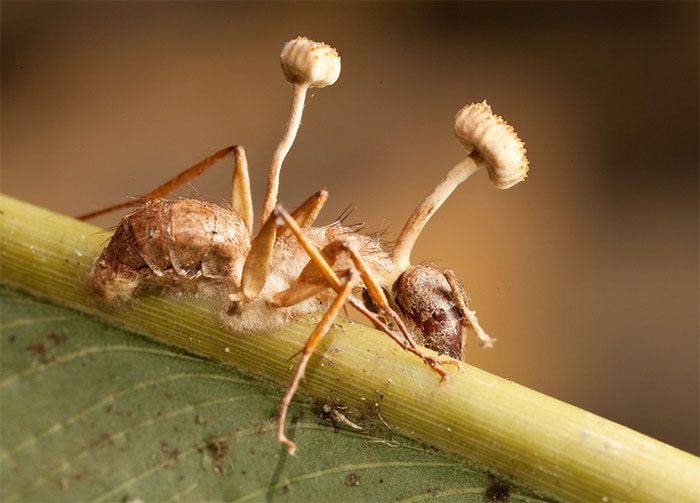Among the 5 million species of fungi in the world, many can pose a danger to humans, including the “zombie” fungus.
What is the “zombie” fungus?
This term refers to fungi from the Cordyceps genus. There are hundreds of species within the Cordyceps genus, each infecting a different type of insect, including larvae, moths, ants, dragonflies, cockroaches, aphids, bees, and beetles.
The spores of the “zombie” fungus infect and germinate inside the host’s body, taking control of its consciousness. When the host can no longer control its own body, it crawls out of its nest, hangs precariously from a leaf, and waits to die. At that point, fungal threads will pierce through the host’s body and release spores into the air.
Of the 600 species of “zombie” fungi in the Cordyceps genus, only about 35 species can control the host’s brain. For example, the fungus Ophiocordyceps unilateralis infects ants.
The first signs of infection from this fungus include erratic and abnormal behavior in the host. Scientists believe that the parasite exerts physical control over its host by developing fungal cells around the brain, taking over the insect’s nervous system to manipulate its muscles.

The “zombie” fungus infects and germinates inside the host’s body, subsequently taking control of that organism’s consciousness – (Photo: STEEMIT)
Geneticist Ivan Will, a fungal expert at the University of Central Florida, states that the “zombie” fungus releases a chemical that alters the host’s DNA, although the precise mechanism behind this remains unclear in scientific research.
However, this is a lengthy process. It is evident that this fungus has been parasitizing its host and evolving over a long period, at least 45 million years ago.
Is there a risk of humans getting infected by the “zombie” fungus?
The answer is “not clearly defined.” Explaining this, João Araújo, a parasitic fungi expert at the New York Botanical Garden, states: “For this fungus to infect any warm-blooded animal, a long evolutionary process would be necessary. If the fungus truly wanted to infect mammals, it would require millions of years of genetic mutations.”
Each “zombie” fungus species has evolved to target a specific insect species, meaning that the most unique fungi will have little impact on organisms outside their intended host species. For instance, a “zombie” fungus evolved to infect a specific ant species in Thailand cannot infect another ant species in the United States.
If it’s challenging for one ant species to jump to another, it’s even more difficult to jump species from animals to humans.
Nonetheless, according to scientists, “difficult does not mean there is no risk.” Every organism on this planet is evolving every day, and they could potentially jump species, transforming in “quality” when they reach a certain “quantity.”
Even without the threat of parasitic “zombie” fungi, many other types of fungi are far more alarming to humans.
Temperature may play a crucial role in this infection process.
It is estimated that millions of fungal species exist worldwide, and a few hundred are known to be dangerous to humans. One factor that has protected us from severe fungal infections is our warm-blooded nature. At around 37 degrees Celsius, the human body is too warm for most fungi to spread infections.
However, one reason we may encounter skin fungi is that they can infiltrate the folds of our skin. These areas are moist, dark, and cooler than the overall body temperature, allowing fungi to thrive.
As the Earth warms, the gap between environmental temperature and body temperature is becoming less pronounced. This change will enable evolved fungi to withstand higher outdoor temperatures, potentially allowing them to survive within the human body as well.
There is a type of fungus capable of infecting humans that scientists believe may be linked to rising temperatures, known as Candida auris. This fungus was not even known to science until 2007. However, in 2011 and 2012, it was unexpectedly found on three different continents and quickly became a significant concern.
When it enters the bloodstream, Candida auris exhibits symptoms similar to bacterial infections. For individuals with weakened immune systems, it can lead to a series of severe health issues, even death.





















































